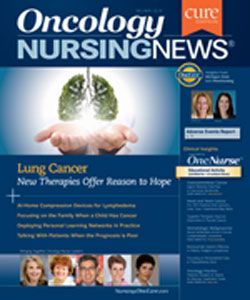Breast Cancer Recurrence ... Many Years Later
One of the great mysteries in oncology practice is the return of breast cancer many years after its initial diagnosis and treatment. And by many years, I mean 15 or even 20 years later, at a time when a woman least expects it to return.
Lisa Schulmeister, RN, MN, APRN-BC, OCN®, FAAN
Editor-in-Chief OncLive Nursing
Oncology Nursing Consultant, Adjunct Assistant Professor of Nursing Louisiana State Health Sciences Center in New Orleans, Louisiana
One of the great mysteries in oncology practice is the return of breast cancer many years after its initial diagnosis and treatment. And by many years, I mean 15 or even 20 years later, at a time when a woman least expects it to return.
Many women are shocked by a breast cancer recurrence, and often say, “But I thought I was cured.” Some of these women thought they were cured when they surpassed the 5-year mark and were even more confident that cancer would not recur when a decade had passed. However, we now know that “cured” is not the best word to use for breast cancer—or any other cancer for that matter, and instead we need to make note of the number of “cancer-free” years postdiagnosis.
More effective therapies and a better understanding of the genomics of breast cancer have led to improved survival rates, and the relative survival rate at 10 years is now 83%. At 15 years, it’s 78%. As a result, the number of breast cancer survivors is growing. However, for some, breast cancer recurs. Breast cancer that comes back within 5 years of diagnosis is called an early recurrence, and breast cancer that comes back 5 or more years later is a late recurrence.
Local recurrence occurs when the cancer recurs in the same localized area of the breast (ipsilateral) as the first tumor, or in the mastectomy/lumpectomy scar. Two-thirds of breast recurrences have been identified as being local recurrences. When breast cancer appears in a different quadrant of the breast or in the other breast (contralateral), it is usually a new tumor. A regional recurrence occurs when the cancer has recurred in the nearby lymph nodes (eg, axillary, subclavicular areas), and a distant recurrence refers to cancer that appear in distant sites, such as the lungs, liver, brain, and bone. Part of the challenge is determining whether a second appearance of breast cancer is a recurrence or a new cancer.
The likelihood of a breast cancer recurrence depends on several factors, including the size of the original tumor, the number of involved lymph nodes, hormone receptor type, the histologic and nuclear grade of the tumor, and how well the woman responded to her first course of treatment. The risk of distal recurrence is the same for women who had a mastectomy or a lumpectomy plus radiation therapy.
Women diagnosed with breast cancer at a younger age have a greater chance of recurrence than those diagnosed at an older age. Even with the recent advances in breast cancer treatment, women under the age of 50 are more likely to experience a local recurrence than women over age 50. Women with BRCA1 and BRCA2 gene mutations are also at a higher risk for contralateral breast cancer after having been diagnosed and treated for an initial breast tumor compared with those who do not have these mutations.
Triple-negative breast cancers have a high risk of recurrence, especially for distant recurrences, compared with receptor-positive tumors. Continuing tamoxifen for 10 years, rather than 5 years, was found to further reduce the risk for recurrence, especially after 10 years; consequently, 10 years of adjuvant endocrine therapy is now recommended.
Although the majority of breast cancer recurrences are the same histology and hormone receptor status, for some women, the recurrence is different from the initial breast cancer diagnosis. It’s not uncommon for women who were ER/PR-positive to recur with breast cancers that are ER/PR negative, or for tumors that were HER2 negative initially to show evidence of HER2 at recurrence.
Unfortunately, many of the risks for the recurrence of breast cancer cannot be altered. The bottom line is that despite the many successes in treating breast cancer, not as much is known about recurrent breast cancer, other than that it can appear in almost any location in the body and at any time after initial treatment—even decades later.

Nurse Practitioners Weigh in on Data From the San Antonio Breast Cancer Symposium
January 16th 2023Loyda Braithwaite, MSN, RN, AGPCNP-BC, AOCNP; and Jamie Carroll, APRN, CNP, MSN, highlight presentations from the 2022 San Antonio Breast Cancer Symposium that will influence oncology nursing practice.



